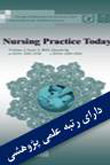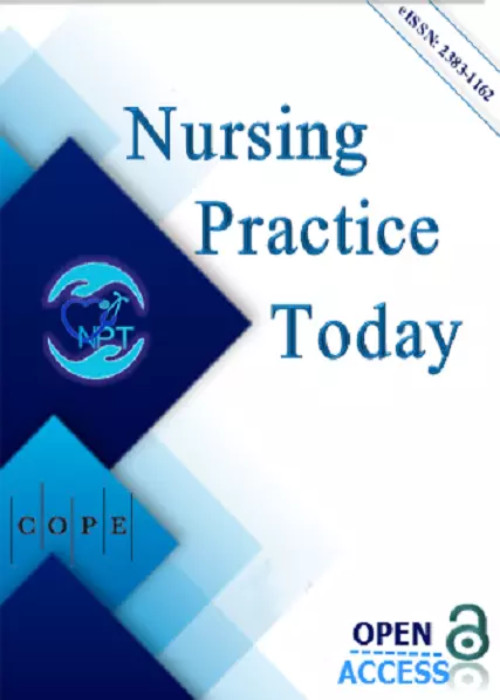فهرست مطالب

Nursing Practice Today
Volume:4 Issue: 1, Winter 2017
- تاریخ انتشار: 1396/02/16
- تعداد عناوین: 6
-
-
Pages 1-10Background and AimDepression is a chronic and overwhelming disorder. One of the factors that could prevent the occurrence of depression is tea consumption. Considering the controversial results of previous studies, the aim of this systematic and meta-analysis review study was to answer this question that whether tea consumption could decrease the risk of depression.
Methods & Materials: By searching the keywords of tea, depressive disorder, depression caffeine, theanine and polyphenols in national and international databases such as SID, MagIran, Google Scholar, IranMedex, Science Direct, Pubmed, ProQuest and Scopus from 2000 to 2016, 12 descriptive and cross-sectional studies about the relation between tea and depression were extracted. Data of the selected studies were analyzed by meta-analysis method and random model effect. Heterogeneity of the studies was evaluated using I2 index. Data were analyzed using STATA 11.2 software.ResultsThe sample size of the present study included 629910 participants with an average of 52493 participants for each study. Results of the present study showed a significant relation between tea consumption and symptoms of depression (95%CI:0.50-0.84, OR = 0.65); in a way that the risk of depression among participants who consumed tea was 35% lower than those who did not consume tea.ConclusionResults of the present study revealed that tea consumption would decrease the risk of depression. Considering the high consumption of tea all around the world and the high prevalence of depression, balance daily tea consumption is recommended as a method for preventing depressionKeywords: tea consumption, depression, meta-analysis -
Pages 11-20Background and AimCaregivers education should be an active and dynamic process. Updated training programs are essential. This research was conducted to assess the effectiveness of virtual education on health care practitioner's self-efficacy in the neonatal unit.
Methods & Materials: In this quasi-experimental research, hospitals affiliated with Tehran University of Medical Sciences that had level one neonatal unit were divided into two intervention and control groups. Sampling was conducted based on the inclusion criteria from all the nurses and midwives who were employed at these units. The intervention group received two months of asynchronous virtual education using learning management system. The control group did not undergo any specific training program. Data of both groups were collected using demographic questionnaire and Schwarzer & Jerusalem' Generalized Self-Efficacy Scale (GSE10) at the first day of the study and two months after the start of the intervention in the form of pre-test and post-test and were statistically analyzed.ResultsBoth of the intervention and control groups were similar regarding their demographic variables. Results showed that there was no significant difference between the mean score of self-efficacy of the two groups before the intervention (p=0.717); but there was a significant difference between the mean score of self-efficacy of two groups after the intervention (PConclusionThe results of this research demonstrated that virtual education programs are effective in increasing the health care practitioner's self-efficacy at level one neonate units. As a result, applying this method of education is recommended to managers and training planners.Keywords: distance education, e-learning, virtual training, self-efficacy -
Pages 21-34Background and AimNurse job-related burnout is a global issue; however, it remains unclear how coping strategies over a maintained period of time may influence nursing burnout. The aim of this study was to evaluation the factors associated with burnout of nurses working at a state hospital.
Methods & Materials: This cross-sectional study was carried out with 446 nurses working at State Hospital in Turkey in 2013. The Maslach Burnout Inventory was used to assess the three components of burnout syndrome: emotional exhaustion, depersonalization and reduced personal accomplishment in this study. The statistical analyses of the data were performed using the Independent Sample T test, One-Way Anova test and Multiple Linear Regression analysis. Level of statistical significance was considered as pResultsThe nurses received a mean score of 17±7 on the emotional exhaustion subscale, they received a mean score of 5±3 on the depersonalization subscale, and they received a mean score of 21±4 on the personal accomplishment subscale of the Maslach Burnout Inventory. Univariate analyses revealed significant relationships between the independent variables of sex, feeling satisfied with the job, following professional publications and the subscales of the Maslach Burnout Inventory. According to the multiple linear regression analyses, feeling dissatisfied with the job had the strongest effect on emotional exhaustion, depersonalization, and reduced personal accomplishment scores.ConclusionFeeling dissatisfied with the job had the strongest effect on emotional exhaustion, depersonalization, and reduced personal accomplishment scores. For this reason, nurses have higher levels of burnout and this is a major occupational health and women's health issue.Keywords: nurses, hospitals, burnout, professional -
Effect of Transcutaneous Electrical Nerve Stimulation on pain intensity in reduced consciousness patients: A randomized clinical trialPages 35-43Background and AimPain is the main stressful factor in patients hospitalized in intensive care units(ICU). Non-pharmacological methods for pain relief are preferred by ICU patients due to lack of considerable side effects. The present research aims to determine the effect of TENS on pain intensity followed by surgery in patients hospitalized in intensive care units. Setting of the study was Besat Hospital in Hamadan, Iran. In this cross over clinical trial, thirty five patients hospitalized in intensive care unit with level of consciousness 9-12 based on Glasgow Coma Scale (GCS), assigned randomly to active/placebo TENS(18 patients) or placebo/active TENS (17 patients) sequence.
Methods & Materials: Patients received each intervention for two hours by a random order. A card was allocated to each patient on which the order of interventions was written. In placebo TENS, the system was off and no electrical simulation was applied. Active TENS was applied by conventional TENS with frequency of 80 Hz within 330 milliseconds that is a subset of high TENS. Pain intensity were measured and recorded using Behavioural Pain Scale (PBS)before and 6 hours after intervention. Statistical analysis used: Data were analysed using SPSS 19 and independent t-test, chi square and Wilcoxon tests.ResultsMean scores of pain intensity before and after active TENS was significantly different in both intervention order (P= 0.001). Mean scores of pain intensity after placebo TENS was not significantly different in both groups. None of patients suffered from side effects after using TENS.ConclusionBased on results, application of active TENS reduced significantly pain intensity in patients after surgery. Concerning the simplicity of using this method and lack of considerable side effects, it is suggested to be used as pain relief in similar situations.Keywords: pain, transcutaneous electrical nerve simulation, non-pharmacological methods, abdominal surgery, intensive care unit -
Pages 44-51Background and AimJob conflict can impact different aspects of work and quality of the presented services. The present study was carried out to determine the level of job conflict and its management styles among the employed nurses.
Methods & Materials: This descriptive cross-sectional study was carried out on 423 employed nurses in different units of the educational hospitals of Kurdistan University of Medical Sciences, Sanandaj, Iran. Data collecting tools were three questionnaires including demographic information, DuBrin Job Conflict questionnaire and Putnam and Wilson's conflict management styles which were completed as self-reporting. The obtained data were analyzed using SPSS (version 16) by descriptive statistics, Chi- square, ANOVA and Spearman correlation tests.ResultsThe results showed that 77.8% of the participants experienced moderate workplace conflicts and 16.5% of them had high conflicts. Nurses were using management styles of controlling conflict (4.1±1.07), avoiding conflict (3.78±0.85) and resolving conflict (2.27±0.82) respectively.ConclusionThe nurses and nursing managers should identify the effective factors on job conflict and decrease its level in workplace. It is necessary that nurses would become familiar with different management styles of conflict to handle it in the right way.Keywords: conflict, management style, nurse, Iran -
Pages 52-63Background and AimTo decrease the rate of caesarean section, complicated intervention for changing behaviors are required. The present study was conducted to evaluate the effectiveness of mindfulness education on anxiety, fear of delivery, pain catastrophizing, and selecting caesarean section as the delivery method among nulliparous pregnant women who referred to Ziaeian Hospital.
Methods & Materials: This clinical trial study was conducted on 38 eligible nulliparous pregnant women who referred to the prenatal clinic of Ziaeian Hospital during the time of the study and candidates for caesarean section. Participants were allocated into two groups of 19. The control only participated in childbirth preparation classes, but the intervention group, also participated in 8 mindful childbirth educating sessions based on the educational method of Nancy Bardacke. Data collection tools were Hartmans Childbirth Attitudes Questionnaire, Spielbergers State-Trait Anxiety Inventory and Pain Catastrophizing Scale. Data were analyzed using SPSS software and independent t-test, Chi square test, Fishers Exact test and covariance analysis.ResultsResults of the study showed significant difference between the two studied groups after the intervention regarding their scores of anxiety, fear of delivery, and pain catastrophizing (pConclusionConsidering the primary efficacy of mindfulness education in this study and the mental, biological and social challenges related to pregnancy and delivery and also, relevantly, low attention to the stress preventive programs and cognitive/behavioral issues of pregnancy and its effects on selecting the type of delivery, Health Ministry could use this program as a supplement for delivery preparation classes.Keywords: caesarean section, mindfulness, anxiety, fear, pain catastrophizing


